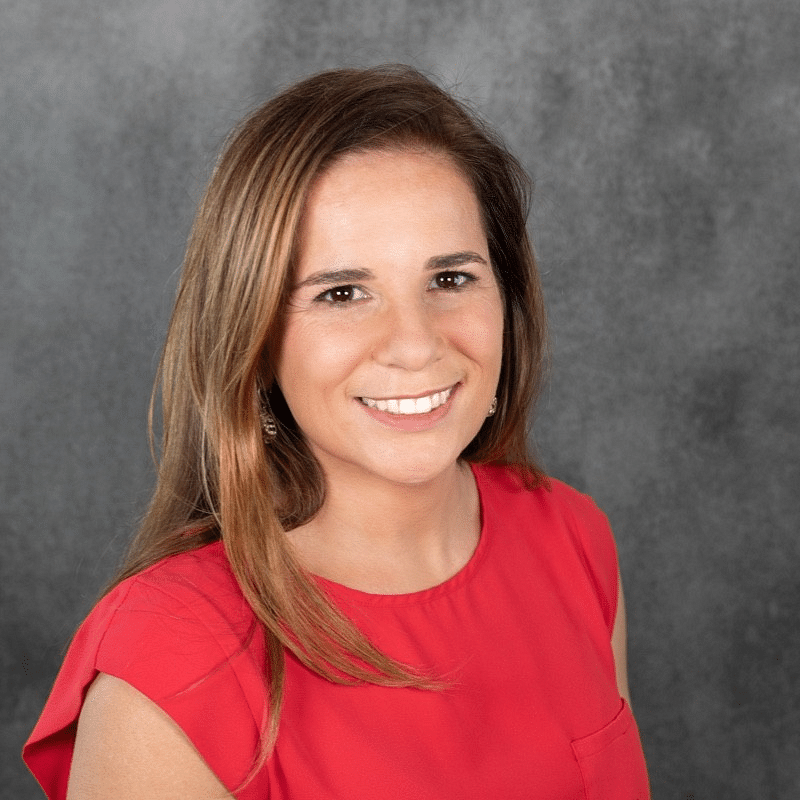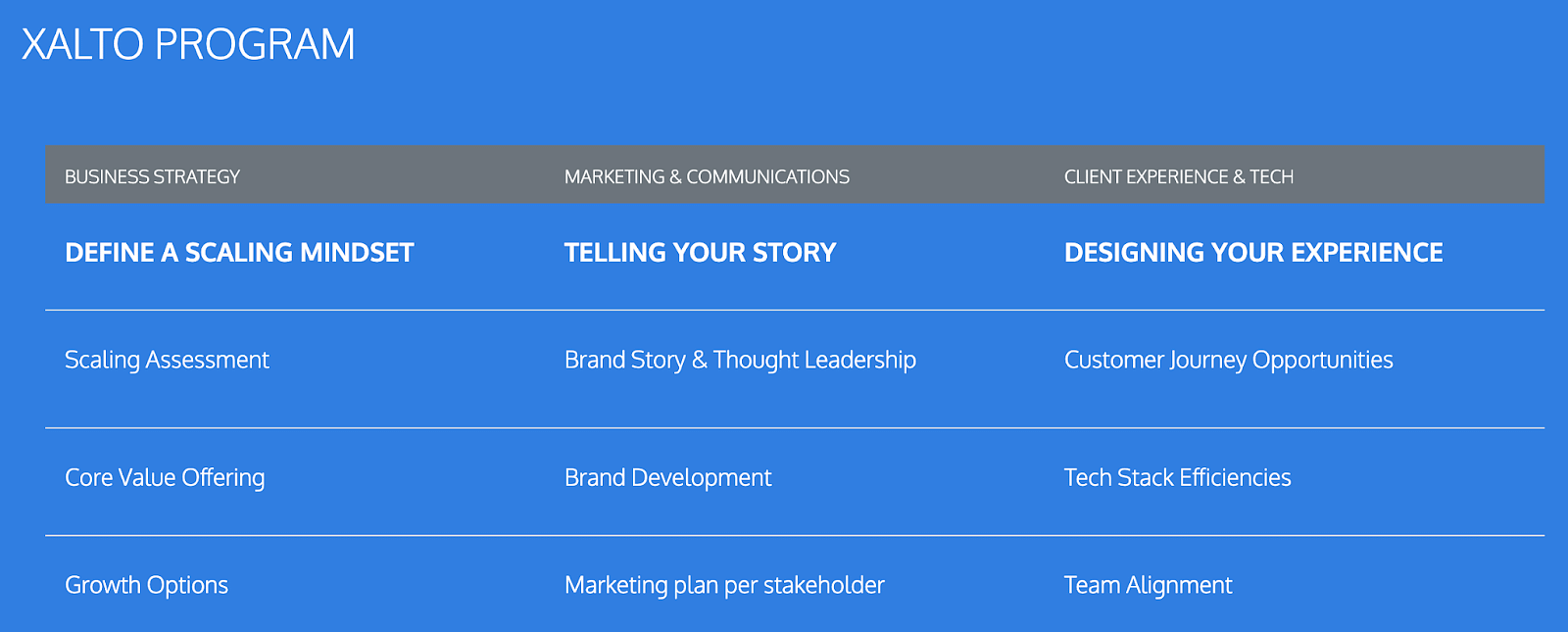
Scaling and winning customer trust: How Scalto helps businesses get noticed
By Jim James, Founder EASTWEST PR and Host of The UnNoticed Entrepreneur.
Originally from Argentina, Alejandra Slatapolsky joined me from Miami in the latest episode of The UnNoticed Entrepreneur podcast. She talked about what they do at Scalto to help businesses get noticed.
Image from LinkedIn
How Scalto is Helping Clients
Scalto has a blueprint called the X Alto program, in which they define the three main verticals you need to scale.
Screengrab from Scalto
Business strategy. For them, the one where you should always start is, is your business strategy. Sometimes, it’s hard to get to that when you’re launching a company. You may leave it behind or say, “I’ll get to the business plan later.”
However, their company has an approach that’s not about sitting down and making a 50-page business plan. They focus on the core value proposition: Look at yourselves inside first. What are you bringing to the world? What’s your purpose? How do you want to impact others?
They’re also big fans of The Golden Circle by Simon Sinek. They do a couple of exercises that just get you to that point of really describing where you’re coming from and why you want to make any pattern in this world.
Then, they go to the other side, the outside. How does that feed the current situation in the world? What are your growth options? What’s the space in the market that you’re going to occupy? There’s no marketing talk, no lead-generation talk, no “What can I sell?” — it’s simply, “What is my business doing in this market and what market is that going to be?”
Marketing communications strategy. Alejandra has a journalistic background and she used to be a journalist before going into public relations (PR) and ending up in marketing and communications.
For her, everything you say and everything you do builds your brand and builds you. Now that everything is digital, what’s online is who you are.
At Scalto, they work on really seeing how you’re going to take ownership of that space that you decided to want to take ownership of and what you’re going to contribute to the world.
For example, I’m in PR and I’ve decided to help entrepreneurs out there. This is my niche and message. I know what I’m going to talk about. And, according to Alejandra, this is what you’ll need when working on content pillars: If you’re going from party to party and networking to networking events, what would you repeat every day? What would you try to teach everybody? These are content pillars and your brand story — and they work on all these.
Then, they also ask: Who are your stakeholders? Who’s involved in your organization? Who do you want to influence? Based on that, they try to do a lead generation process for each of them; it’s different from each other. Every target is not in the same space, room, and platform. They don’t have the same interests. This is why they advise personalising these.
Customer journey. The third component that they work with is the customer journey. Alejandra is a huge believer that client experience is making a break in companies right now. No matter what type of company you are, your client has to have superb experiences. In the biggest companies in the world such as Amazon, Facebook, and Google, everything is seamless.
Image from Unsplash
So whatever you do, go back to how your client is experiencing your process. Take a look and improve all the time. This is the work that they do when working with client experience.
It Boils Down to the Right Strategy
Scalto also has what they call the marketing engine. It sort of works as a traditional marketing communication platform for clients. This is where they do the awareness, the “getting noticed” part — everything that you need to do day-to-day to work on your marketing process.
The question is, how do they scale that process?
Alejandra shared that with her years working in an agency and as a marketer, she has had too many people coming to her and saying, “Hey, I need a website” or “Hey, I need leads.” It’s one single thing that they’re always looking for — the thing that they think is the solution. When this happens, she always has to go back and ask them: What is your strategy? Where are you trying to get to?
She wants to make sure that the tool that you’re asking for is the right answer. Because there are already many times that it ended up not being the right answer.
And this is the beauty of the customer journey. When you really analyse lead to loyalty, everything happens in between. When she talks to Chief Executive Officers (CEOs) and entrepreneurs, she tells them this all the time: “It’s not a problem of lead generation. I’m sure you can find a cheaper lead down your funnel, down your journey. I’m sure there are cheaper leads in the middle that you’re missing because you’re losing in the conversion process.”
This is what happens if you really work on it constantly and you rethink the way you’re using your strategies and not just do them because you see everybody doing it.
The Case of FinTech
Finance Technology or FinTech is an area where Alejandra is particularly skilled in. The technology aspect is what this niche has that traditional financial services don’t.
With most of the FinTechs that she ran into, the main challenge that they have is trust-building.
You have no problem buying soap or a dress online. But buying financial services — transferring money into a fund that you don’t know about or buying bonds, for instance — is still an issue that people are having trouble with. It’s especially true to high net worth or ultra-high net worth individuals because they’re used to a very personalised approach to that service.
Image from Unsplash
This is the main issue that FinTechs have: They think that they can put the product out there and, just like opening a Facebook account, people will use it.
When asked about overcoming that trust issue, Alejandra pointed out that they have to work a lot on thought leadership, exposure, augmentation, and hyper-segmenting your targets.
For example, she has a client that has a product for Latin Americans. And Latin America has millions and millions of people who are more segmented than other territories. Therefore, you have to really communicate with them in a way that the message is just right for them. A message that’s talking about their very specific pain. Once you find them, you start nurturing them, talking to them, and providing solutions and ideas to problems that you know that they have. Simply put, become a super knowledgeable person about your client.
When you go to a bank branch and open a bank account, it’s pretty straightforward. You have people in front of you and you know what they’re doing; they’re showing what they’re doing. In technology, almost everything is in the background. Hence, as a player in this field, you have to open up as much as possible.
But this is what financial service companies have been historically very bad at — compliance and all things related to that. They can’t show that much or tell clients what they’re going to do because a compliance body is going to stop them from doing so.
However, it’s still about being open and simple. It’s about really connecting constantly and saying, “I know you have this pain, let me solve it for you.”
Customer Journeys, How Do You Map Them Out?
Talking about mapping out the customer journey, Alejandra stated that the bigger your organisation is, the harder it’s going to be.
In retail, there’s a lot of talking about the mystery shopper. You have to do that exercise and put yourself in the shoes of your customer. So if you can do mystery shopping, do it and go ahead because it will really work for you.
However, if you can’t do it because it will be difficult for you, Alejandra discussed another way.
During the podcast episode, she shared that she misses the times when people would go together in a meeting room, grab Post-its, and start saying, “Okay, I have Facebook, LinkedIn, Twitter. These are where my data is coming from.” Then, the conversation will go to “The customers are going to my website. Where are they landing? What team is getting that? Whose face are they seeing?” After that, it will be, “What happens once they see that face? Who do they talk to?”
Image from Unsplash
Think of it in terms of touchpoints and make that path, describing each touchpoint — who they see, what email they get, what webpage they see. Sometimes it’s very simple; sometimes, it’s very complex. It really depends on your organisation. If you can’t do it with your team, then split it up among awareness, conversion, and service.
If we say awareness, it pertains to “What happens right before a client comes to your website or gets in touch with you?” Conversion is, “What happens between the first time that they hear from you until the time that they actually buy from you.” There are many things that happen in between. So keep in mind that it requires a lot of touchpoints for them to buy from you.
If you’re looking for tools for customer journey building, you’ll find a hundred. But one that Alejandra likes is a collaboration tool called Miro. It will help you manage meetings, collaborate in real-time, and build customer journeys together.
On Dual-Language Marketing
Alejandra is bilingual, speaking English and Spanish. She has her own consultancy service. And when asked about what companies should avoid if they’re doing dual languages is to never just translate. Instead, localise or at least use a filter.
Your product may be the same but there’s always a switch, a conversion, and adaptation to be made whenever you enter a new culture. And you have to be conscious about it.
Her business is helping a lot of Latin American companies enter and scale in the US. And the main issue that they have is that most of them don’t understand the magnitude of the US market. Her company is helping European companies into the US, too. And the same thing happens — they lose sight of the amount of money that there is in the market.
But apart from that, you also have to look at the amount of offer and competition that you have.
This is when everything about finding a niche becomes more and more important. For Alejandra, it’s all about finding your niche.
Recently, she was talking to somebody and they think that they’ve already found theirs. She nonetheless emphasised that it is not enough. When you find your niche, make it smaller. And this is always her answer.
Marketing Herself as An Entrepreneur
When it comes to marketing herself as an entrepreneur, Alejandra said that she’s taking her own medicine. She’s doing content and she has her own podcast. They create content online, they write blog posts — they try to add value as much as they can.
For many years, she has only worked through word of mouth. It was good and she didn’t need that much more. She knew that with her niche — work management of the FinTech scene — it was actually an easy conversion, honestly speaking. When you put her in front of a CEO in that area, they’ll see that she understands their business. Because of that, the conversation is really high.
However, when you grow, you have to figure out a way to make it bigger. You have to scale and go beyond your personal brand connections.
Nonetheless, Alejandra shared that, honestly, she hates networking events. She doesn’t have the time to write. So she decided to sit down and say, “What do I like doing?” She realised that what she loves are one-on-ones like what we did on the podcast.
This is why she thought of having strategy sessions with entrepreneurs and with people in the industry, and that got them converted. She records those strategy sessions and that is how her podcast started.
Image from Unsplash
A lot of entrepreneurs think that a podcast has to have a return on investment (ROI) directly. It has to have millions of downloads or whatever. However, she pointed out that the podcast is just one component that helps you create all these materials for you to be out there.
This is what she called a marketing engine, too. They do digital events to help feed their need for content. As an entrepreneur, you don’t need to spend that much time. You can do your own podcast, put your team to extract the content, and reuse it (which is similar to what I do). It’s pretty simple if you have the team behind it. Just make sure that you have the team that creates the content the way you like it.
For instance, Alejandra’s partner doesn’t like to be on camera but she’s a genius at doodling. She can work on her iPad for 45 minutes and show you a summary of the conversation that she heard. They started recording explaining concepts while she’s doodling.
The point here is to find what you like doing and where you feel comfortable, and expose it. Don’t try to do whatever the other one is doing. If you like writing, write. If you like speaking, speak — whatever it is that makes you feel more comfortable.
To learn more about Alejandra Slatapolsky, reach out to her at or visit Scalto’s website.
This article is based on a transcript from my podcast The UnNoticed Entrepreneur, you can listen here.
Cover image by krakenimages on Unsplash







